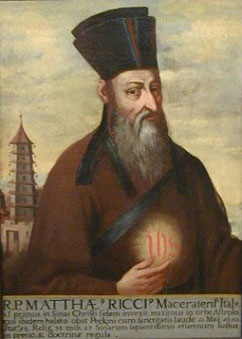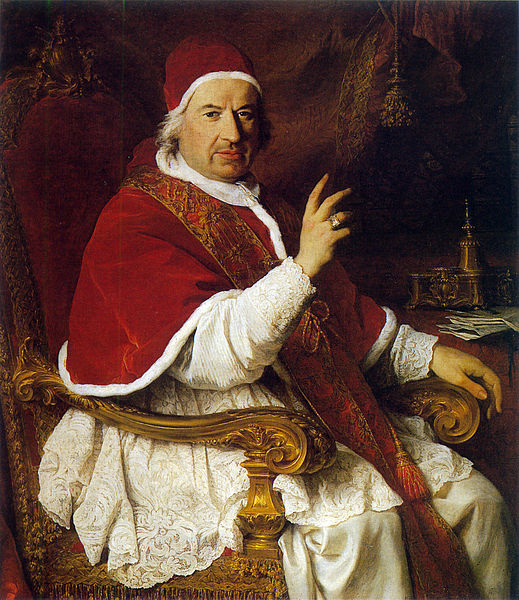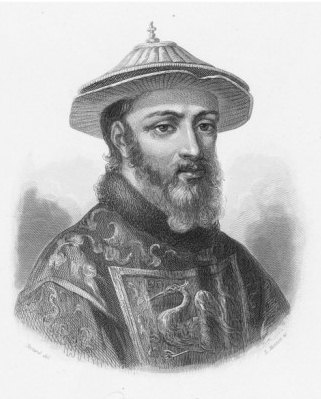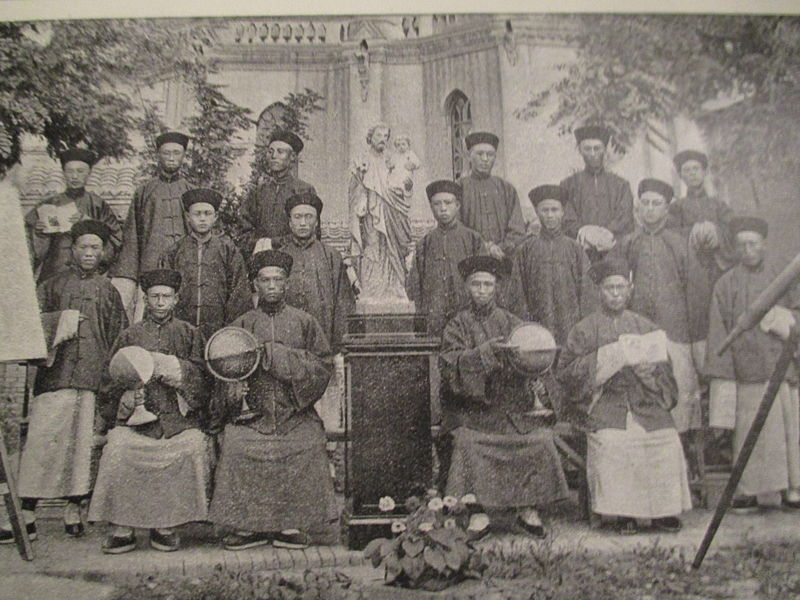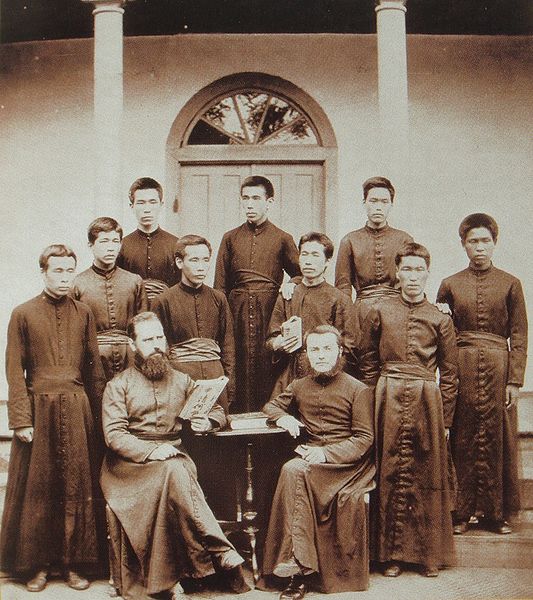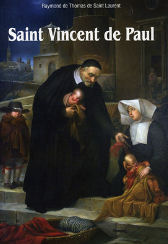Part II
THE QUESTION OF RITES
Father Ricci, the first superior of the Jesuits in China, had remarkable success in his work of evangelizing because of the great tolerance he showed the cult rendered by the Chinese to Heaven, to Confucius, and to ancestors. Indeed, mandarins being obliged to honor officially Heaven and Confucius on certain days, it would have been difficult to convert any of them if they had not been allowed to carry out the functions of their office. Ancestor worship is, practically, the principal religion of China. Ricci’s successor, Longobardi, was of a different mind and finally in 1628, when Emmanuel Diaz (Junior) was vice-provincial, a meeting was called to study the question, but no decision was reached. Affairs reached a crisis when the Dominican, Moralez, and the Franciscan, Santa Maria, arrived in China (1633). Excess of zeal, ignorance of local customs, or some such reason was the cause of the expulsion of the Dominicans and Franciscans (1637). In addition to different views about the religion of the Chinese, there was another cause of discord between the Jesuits and the Dominicans. The former were protected by Portugal and their protectors were at Macao. The latter were Spaniards, and they looked for support to Manila. In 1639, Moralez addressed to Diaz Senior, then Visitor of the Jesuit mission, a memorandum in twelve articles regarding Chinese practices. Diaz having delayed his answer, Moralez went to Rome, and on 12 Sept., 1645, obtained from Innocent X a decree condemning the Jesuits. The Jesuits thereupon dispatched to Rome Martin Martini, who after a stormy voyage was carried to the Norwegian coast, and was obliged to cross Holland and Germany to Italy. He succeeded in having a contradictory decree issued by Alexander VII (23 March, 1656). Then followed a new memorandum of Moralez to the Sacred Congregation (1661), and a new decree of Clement IX against the Jesuits (20 Nov., 1669). Moralez died (1664) but his successor as prefect of the Dominicans in China, Domingo Fernandez Navarrette, published his “Tratados historicos”; the Dominicans, however, found an adversary among themselves. The Chinese Dominican, Gregorio Lopez, Bishop of Basilea and vicar Apostolic of Nan-king, sent to the Sacred Congregation a memoir in favour of the Jesuits.

Fr. Nicolò Longobardo was the Superior General of the Jesuit China mission in 1610 until 1622. He remained preaching in China until he was 90 years old.
New elements were brought into the discussion when French Jesuits and priests of the Missions Etrangères arrived in China. The publication in Paris, in 1682, of a work entitled “La Morale pratique des Jésuites”, a bitter criticism of the Jesuits, acted as a firebrand. Père le Tellier answered with “Défense des Nouveaux Chrétiens” (1687), which was later censured at Rome (23 May, 1694). On 26 March, 1693, Charles Maigrot, of the Missions Etrangères, vicar Apostolic of Fu-kien, and later titular bishop of Conon, issued a mandate condemning the Chinese Rites. Following the example of the Dominicans, the Missions Etrangères sent to Rome Louis de Quemener, who presented the pope with Maigrot’s mandate (1696). Nicolas Charmot, Maigrot’s envoy, obtained a brief from Innocent XII (15 Jan., 1697) and a decree from the Holy Office (3 July, 1697). The works of Jesuit Father Comte. “Mémoires sur la Chine” and “Lettre ê Mgr le Due du Maine sur les cérémonies de la Chine”, added fuel to the flame and were censured by the Faculty of Theology of Paris (18 Oct., 1700), together with the “Hist. de l’edit de l’Empereur de la Chine” by Père Le Gobin, S. J. Finally, the Holy Office published a decree prohibiting the Chinese ceremonies (20 Nov., 1704). This was approved by Clement XI who appointed as legatus a latere Charles Thomas de Tournon, Patriarch of Antioch, to carry the decree to China. Tournon arrived at Canton 8 April and was received at Peking by the Emperor K’ang-hi, who was favorable to the Jesuits (31 Dec., 1705). After various controversies in which Maigrot and the Jesuit Visdelou sided with the legate, K’ang-hi, who found the Jesuits better informed about China than their adversaries, ordered Tournon to leave Peking (28 Aug., 1705) and banished Maigrot (17 Dec., 1705). Tournon issued a mandate at Nan-king (25 Jan., 1707). When he arrived at Macao he was thrown into a prison where he died (8 June 1710) immediately after being named a cardinal. On 19 March, 1715, Clement XI issued the Bull “Ex illâ die”. A new legate, Mezzabarba, Patriarch of Alexandria, was sent to China. He arrived at Macao (26 Sept., 1720), went to Peking and was received by the emperor, who refused to accede to his demands.
Finally, the whole knotty question was settled (11 July, 1742) by a Bull of Benedict XIV, “Ex quo singulari” condemning the Chinese ceremonies and choosing the expression T’ien-chu which was to be used exclusively to designate God. Missionaries to China had to take an oath not to discuss at any time the terms of the Bull. The bitterness of this celebrated quarrel was greatly increased by various causes: the rivalry of Portugal and France for the protectorate of the missions, the disputes between the Jansenists and the Jesuits, and the Bull “Unigenitus”; while the final decision was delayed as much by the question of episcopal sees in China as the rites themselves. Rome having spoken, no more can be said here on the question, but it may be noted that the Bull “Ex quo singulari” was a terrible blow to the missions in China; there are fewer Christians than formerly and none among the higher classes, as were the princes and mandarins of the court of K’ang-hi.
CREATION OF VICARIATES APOSTOLIC
In 1577 Gregory XIII created for China, Japan, and the Far Eastern Islands, the Diocese of Macao, which was divided in 1587 into two diocese, Macao and Funay (Japan). On 9 Sept., 1659, Alexander VII erected from the territory included within the Diocese of Macao, two vicariates Apostolic, one including besides Tong-king the Chinese provinces of Yun-nan, Kwei-chou, Hu-kwang (now Hu-pe and Hu-nan), Sze-ch’wan, Kwang-si, and Laos, the other including, in addition to Cochin-China, the Chinese provinces of Che-kiang, Fu-kien, Kwang-tung, Kiang-si, and the island of Hai-nan. In 1690, Alexander VIII, to satisfy the Portuguese, created the Diocese of Peking, including Chi-li, Shang-tung, Shan-si, Shen-si, Ho-nan, Lao-tung, Korea, and Tatary, and the Diocese of Nan-king, both diocese being under the Archbishop of Goa.
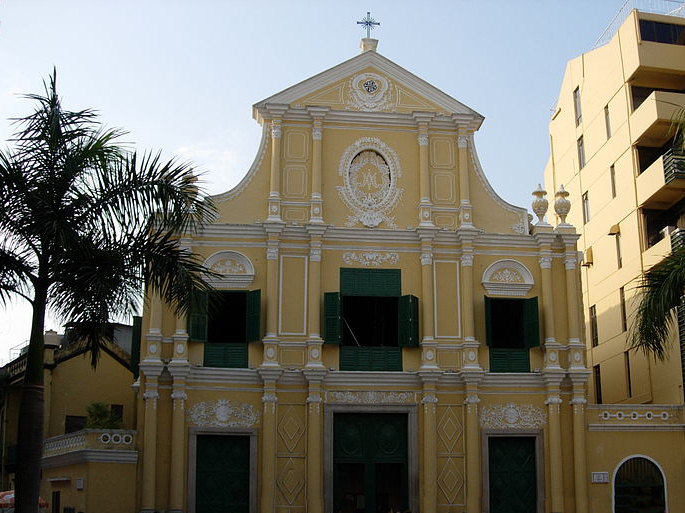
St. Dominic’s Church in Macau. The church was established in 1587 by three Spanish Dominican priests who arrived from Acapulco, Mexico.
By a Bull of 15 Oct, 1696, Innocent XII erected the vicariates Apostolic of Shen-si and Shan-si by taking part of the territory included in the Diocese of Peking (Chi-li, Shang-tung, Lao-tung, Korea, and Tatary), and limited the Diocese of Nan-king to Kiang-nan and Ho-nan. The following vicariates were created out of the Diocese of Nan-king (1696): Hu-kwang, Fu-kien, Che-kiang, Kiang-si, Yun-nan, Sze-ch’wan, Kwai-chou; in 1737, these last two provinces were joined into one vicariate, to which Yu-nan was added in 1781. In 1840, Yun-nan was again detached, and in 1846 Kwei-chou became independent. In 1858 Sze-ch’wan was subdivided into Eastern and Western Sze-ch’wan. In 1860, Eastern Sze-ch’wan, with part of Western Sze-ch’wan, was divided into the vicariates Apostolic of Southern Sze-ch’wan and Eastern Sze-ch’wan. In 1790, Fu-kien, Che-kiang, and Kiang-se were combined into one vicariate, but in 1838 divided into the vicariates of Fu-kien and Che-kiang Kiang-se. In 1883, Amoy was separated from Fu-kien; in 1846 Kiang-se was separated from Che-kiang; in 1879 the vicariates of Northern and Southern Kiang-se were erected; in 1885 the vicariate of Eastern Kiang-se was created. In 1762, Hu-kwang was amalgamated with Shan-si and Shen-si but separated in 1838. Out of Hu-kwang were formed in 1856 the vicariates of Hu-nan and Hu-pe; in 1879 Hu-nan was divided into the vicariates of Northern and Southern Hu-nan; in 1876, Hu-pe was divided into Eastern, Western, and Northern Hu-pe. In 1843 Shen-si and Shan-si were separated; in 1885 Shen-si was divided into two vicariates, and in 1890 Shan-si was divided in a similar manner.
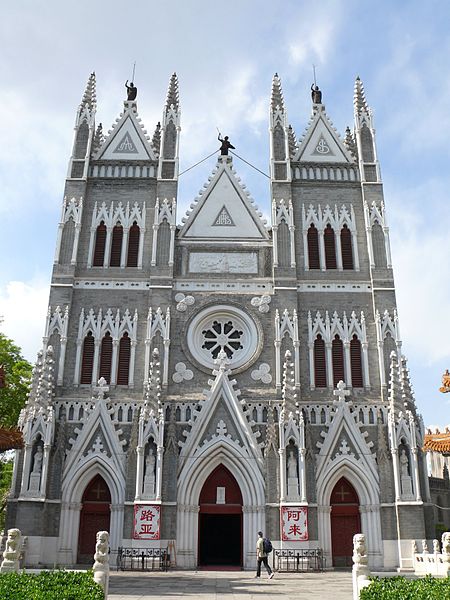
Xishiku church, Beijing, China, built in 1890, under the direction of Lazarist missionary Bishop Pierre-Marie-Alphonse Favier (1837-1905), who designed it. In June, 1900 the Boxers besieged the Beitang Cathedral. Photo by Peter Potrowl.
From the Diocese of Peking, Korea was detached in 1831, Liao-tung, Manchuria, etc. in 1838, and Shang-tung in 1839; in 1856 the Diocese of Peking was divided into three vicariates: Northern, South-Western, and South-Eastern Chi-li; from the last-named, eastern Chi-li was separated in 1899. In 1883, Shan-tung was divided into Northern and Southern Shan-tung; Eastern Shan-tung was detached in 1894. In 1840 the vicariates of Mongolia and Kang-su were separated from Manchuria and later sub-divided; in 1843, Hong-Kong was taken from Macao; at first a prefecture, it was erected into a vicariate in 1874; the two provinces of Kwang-tung and Kwang-si were detached from Macao in 1856 and formed into a prefecture, but were erected into separate prefectures in 1878. In 1856 Ho-nan was divided from the Diocese of Nan-king, and was erected into a vicariate which was later subdivided.
RELIGIOUS ORDERS
The Society of Jesus

Frontispiece depicting Clockwise from top left: St. Francis Xavier, St. Ignatius of Loyola, Fr. Matteo Ricci and Fr. Johann Adam Schall von Bell (bottom left) holding a map of China.
The Jesuits are the true founders of the missions in China. St. Francis Xavier, after evangelizing India and Japan, died in December, 1552, on the island of Shang-ch’wan (St. John’s) before he could reach Macao or Canton. His successors, Alessandro Valignani (d. 20 Jan., 1606), Michele Ruggierei (d. 11 May, 1607), and Francisco Pasio (d. 30 Aug., 1612) did not penetrate beyond these two places and Chao-k’ing in the same province. Matteo Ricci had the honor of being the pioneer missionary at Peking; he was born at Macerata, Italy, 6 Oct., 1552, and arrived at Macao in 1583, meeting there with Ruggieri. From Chou-k’ing Father Ricci went to Nan-ch’ang (1595); he visited Peking twice (1595 and 1598) where he finally settled, leaving Nan-king for the last time 18 May, 1600. He left behind him Lazzaro Cattaneo and Joïo da Rocha, who in 1603 baptized, under the name of Paul, the celebrated Siu kwang-k’i. The latter on going to Peking showed himself a stanch supporter of Ricci, who died 11 May, 1610. Ricci was the first superior of the Peking mission. His two successors, Nicolò Longobardi (1610) and Joïo do Rocha (1622) held the same office; Emmanuel Diaz (Junior) was the first vice-provincial. Ricci, under the Chinese name of Li Ma-teu, wrote many works still appreciated by the Chinese, among them “T’ien-chu Shi-yi” (the true doctrine of God), published in 1601, translated into Manchu, Korean, Japanese, and French; “Ki-ho Yuan-pun”, the first six books of Euclid, etc.
The following are the names of some of the best-known members of this mission: Emmanuel Diaz Junior (Yang Ma-no), b. in Portugal, 1574; arrived in China, 1610; d. at Hang-chou, 4 March, 1659; author of “T’ang-king kiao-pei-sung-cheng-ts’iuen”, a translation of the celebrated inscription of Si-ngan-fu. Nicolas Trigault (Kiu Ni-ko), b. at Douai, 3 March, 1577; arrived in China, 1610; d. at Hang-chou, 14 Nov., 1628; author of the life of Ricci (De Christianç Expeditione apud Sinas, 1615), a dictionary (Si-ju-eul-mu-tze), and a translation of Æsop’s Fables (Hwang-yi). Giulio Aleni (Ngai Ju-lio), b. at Brescia, 1582; arrived in China, 1613; d. at Fu-chou, 3 Aug., 1649; author of no less than twenty-five works in Chinese, including a life of Christ. Johann Adam Schall von Bell (T’ang Jo-wang), b. at Cologne, 1591; arrived in China, 1622; d. at Peking, 15 Aug. 1666; a celebrated mathematician. Luigi Buglio (Li Lei-sse), b. at Minco (Sicily) 26 Jan., 1606; arrived at China, 1637; d. at Peking, 7 Oct., 1682; author of twenty-one works in Chinese, of which a “Missale romanum” (Mi-sa King-tien, 1670), a “Breviarium romanum” (Ji-k’o kai-yao, 1674), a “Manuale ad Sacramenta ministranda” (Sheng-sse-li-tien, 1675), still remain. Gabriel de Magalhaens (Ngan Wen-see), b. at Pedrogïo, 1611; arrived in China, 1640; d. at Peking, 6 May, 1677; author of a good description of China which was translated into English (1688). Martino Martini (Wei Kwang-kwo), b. at Trent, 1614; arrived in China, 1643; d. at Hang-chou, 6 June, 1661; who published in 1655 the first good atlas of China. Ignaco da Costa (Kouo Na-tsio), b. at Fayal, Azores, 1599; arrived in China, 1634; d. at Canton, May, 1666; the translator, with Intorcetta, of the “Lun-yu” and “Ta-hio” of Confucius (1662). Prospero Intocetta (In To-che), b. at Piazza, Sicily, 28 August, 1628; arrived in China, 1659; d. at Hang-chou, 3 Oct. 1696. Phillippe Couplet (pe Ing-li), b. at Mechlin, 31 May 1622; arrived in China, 1659; died at sea, 16 May, 1693; he made known to Europeans the works of Confucius (1672). Albert Dorville and Johann Gtüber, who visited Tibet. Ferdinand Verbiest (Nan Hwai-jen); b. at Pitthem, 9 Oct., 1623; arrived at China, 1659; d. at Peking, 29 Jan., 1688; a great astronomer, who cast some of the instruments of the Peking observatory and guns for the war against the Eleuths. Franïois Noæl (Wei Fang-tsi), b. at Hesdrud (Hainault), 18 Aug., 1651; arrived in China in 1687; d. at Lille, Sept., 1729; astronomer and translator of the Confucian classics. Ignaz Kögler (Tai Tsin-hien), b. at Landsberg, 11 May, 1680; arrived in China, 30 Aug.,1716; d. at Peking, 29 March, 1746. Augustin von Hallerstein, b. at Laibach, 2 Aug., 1703; arrived in China in 1738; d. 29 October, 1774. The last two named were mathematicians.
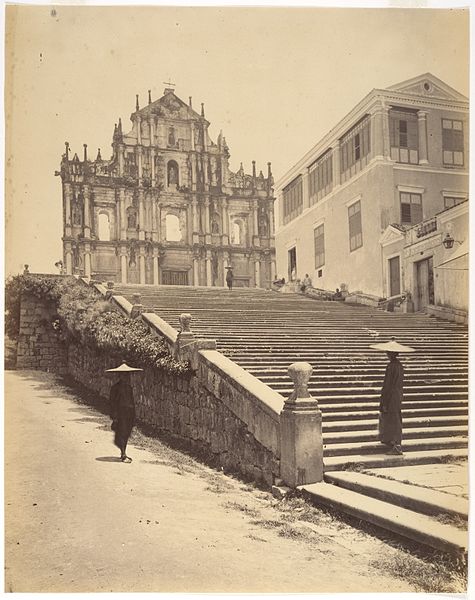
The Ruins of St. Paul’s, also known as College of Madre de Deus, are the ruins of a 16th-century complex in Macau including what was originally St. Paul’s College and the Church of St. Paul also known as “Mater Dei”, a 17th-century Portuguese church dedicated to Saint Paul the Apostle. The College was the base for Jesuit missionaries traveling to China, Japan and East Asia and the first Western university in East Asia. After a revolt, Japan expelled the Portuguese, banning Catholicism, and the college became then a shelter for fleeing priests. The Jesuits abandoned it in 1762 when they were expelled by the Portuguese authorities, during the suppression of the Society of Jesus. The buildings were destroyed in a fire in 1835 and just the Church front still stands.
Most of the Jesuits of this mission were Italian, Portuguese, Spanish, German, Swiss, or Belgian; but few were French. In 1685, however, Louis XIV, king of France, sent six French Jesuits to the Far East: Guy Tachard remained in Siam, but Jean de Fontaney, Joachim Bouvet, Louis de Comte, Jean-Franïois Gerbillion and Claude de Visdelou, who reached China 23 July, 1687, laid the foundation of the celebrated French Peking mission, which lasted till the suppression of the Society.
Their mission under the protectorate of the French king was distinct from the mission of the other Jesuits, who were known in a general manner as “Portuguese”, to distinguish them from their French brethren. the superiors of the French mission were: Jean de Fontaney (1687), Gerbillion (1699), Dentrecolles (1706), Julien-Placide Hervieu (1719), Joseph Labbe (1736), Hervieu, a second time (1740), Valentin Châlier (1745), Jean Sylvain de Neuvialle (1747), Louis-Marie Du Gad (1752), Neuvialle, a second time (1757), Joseph-Louis Le Febrve (1762), John-Baptiste de la Roche (1769), and Franïois Bourgeois.
The following are the names of the most remarkable among the French Jesuits:
- Jean-Franïois Gerbillion (Chang Ch’eng), b. at Verdun, 21 Jan., 1654; arrived at China, 1687; died at Peking, 22 March 1707. Having been superior of the house at Peking he was appointed, 3 Nov., 1700, superior of all the French Jesuits in China. He was the interpreter for the treaty signed with Russia at Nerchinsk in 1689, and the author of a Manchu grammar.
- Claude de Visdelou (Liu-in), b. 12 Aug., 1656, in Brittany; d. at Pondicherry, 11 Nov. 1737. He arrived in China in 1687. He left the Society, was appointed vicar Apostolic of Kwei-chou and Bishop of Claudiopolis (12 Feb., 1707). His very valuable “Historie de la Tartarie” was published as an appendix to B. d’Herbelot’s “Bibliothèque orientale” (1780).
- Joachim Bouvet (Pe-tain), b. at Man, 18 July, 1656; arrived in China, 1687; d. at Peking, 28 June, 1730; a man of great activity.
- Franïois-Xavier Detrecolles (in Hong-siu), b. at Lyons, 5 Feb. 1663; arrived in China, 1698; d. 2 July, 1741; authors of various papers of scientific value.
- Joseph-Marie de Prémare (Ma Jo-shi), b. at Hâvre-de-Grâce, 17 July, 1666; arrived in China, 1698; died at Macao, 17 Sept., 1736; author of the well-known “Notitia Linguæ Sinicæ”, published at Malacca in 1831 at the expense of Lord Kingsborough.
- Dominique Parrenin (Pa-To-ming), b. at Russey, 14 Sept., 1665; arrived in China in 1698; d. at Peking, 29 Sept., 1741; a learned and influential man, author of the Chinese lives of St. Aloysius Gonzaga (Tsi-mei-pien) and St. Stanislaus Kostka (Te-hing-p’u).
- Antoine Gaubil (Sun-kiun-yung), b. at Gaillac, 14 July, 1689; arrived in China in 1722; died at Peking, 24 July, 1759; remarkable as astronomer, historian, and geographer.
- Pierre d’Incarville (T’ang), b. 21 Aug., 1706; arrived in China, 1740; d. at Peking, 12 May, 1757; well known as a botanist.
- Jose-Marie-Anne de Moyria de Mailla (Fung Pin-cheng), b. at Moirans (Isère), 16 Dec., 1669; arrived in China, in 1703; died at Peking, 28 June, 1748; translator into French of the huge Chinese historical work “T’ung-kien-kang-mu” (ed. Grossier, 13 vols. 4to, Paris, 1777-1785).
- Jean-Joseph-Marie Amiot (tsien Teh-ming), b. at Toulon, 1718; arrived in China in 1750; d. at Peking, 9 Oct., 1793; the most active contributor to the “Mémoires concernant les Chinois” and a regular correspondent of the French Minister Bertin.
Numerous and important works were compiled or written by these hard-working missionaries. Among these are: (1) Maps of China. This labour was undertaken by order of the Emperor K’ang-hi and executed between 1708 and 1718, under the direction of Father Jartoux, by Bouvet, Cardoso, Bonjour (Augustinian), Mailla, Hinderer, de Tartre, and especially Fridelli and Régis. They were the basis of d’Anville’s celebrated maps issued between 1729 and 1734. (2) “Déscription geographique de la Chine” by J. B. Du Halde (Paris, 1735), compiled from materials sent by twenty-seven missionaries in China. (3) “Lettres édifiantes et curieuses”, a collection of letters from missionaries in all parts of the world, begun in 1702 by Charles Le Gobien, and after his death by Du Halde, Patouillet, and Maréchal (34 vols., 1703-76). This work was reprinted in 1780-83 by Yves-Mathurin-Marie de Querbeuf. There have been numerous editions and translations since. (4) “Memoires concernant l’histoire, les sciences . . . des Chinois” (Paris, 1776-1814), containing a mass of information sent mainly by Amiot and Cibot, and edited by Brotier, Bréquigney, and others; the last volume, containing the end of the history of the T’ang dynasty, was edited by Sylvestre de Sacy. (5) Sixteen plates drawn by order of Emperor K’ien-lung to commemorate his conquests in Central Asia. The artists at Peking were Jean-Denis Attiret (d. 8 Dec., 1768), Jean Damascène, Giuseppe Castiglioni, Ignaz Sichelbarth, all Jesuits except Damascène, an Augustinian. The plates were engraved at Paris under the direction of C, N, Cochin. Besides Attiret there was another Jesuit painter at the imperial court, Giuseppe Panzi (b. at Cremons, 2 May, 1734).
The Jesuits had four churches at Peking. The Northern or French church (Pe-t’ang), the Southern or Portuguese church (Nun-t’ang), the Western church (Si-t’ang), and the Eastern church (Tung-t’ang), the old house of Adam Schall. The two beautiful cemeteries of the Jesuits outside the walls of Peking, one Portuguese (Sha-la-eul or Téng-kong-che-lan), the other French (Ch’eng-fu-sse), were destroyed by the Boxers in 1900. The Jesuits had residences in the provinces of Chi-li, Shan-si, Shen-si, Shan-tung, Ho-nan, Sze-ch’wan, Hu-kwang, Kiang-si, Kiang-nan, Che-kiang, Fu-kien, Kwang-tung, and Kwang-si. The Jesuits, on their suppression in 1773, were replaced by the Lazarists. The Jesuit Archbishop of Nan-king, Xavier von Laimbeckhoven, an Austrian, died 22 May, 1787, near Su-chou. There were but few fathers at Peking when the news of the suppression of the Society reached the Chinese capital, Sept., 1774. Hallerstein and Benolt died of grief; the last member, Louis de Poirot, died before Oct., 1815.
In 1841, Luigi de Besi, Vicar Apostolic of Shan-tung and Ho-nan, was also placed temporarily in charge of the diocese of Nan-king. The work was too heavy for one man, and Monsignor de Besi wrote to the General of the Jesuits (18 Sept., 1841), asking that some missionaries be sent to help him as soon as possible. The Christians of Kiang-nan had already applied to the general, the Very Rev. Father Roothan (25 April, 1832) to the Queen of Portugal (1838), and to Pope Gregory XVI (1840). At last, two Jesuits, Claude Gotteland (b. in Savoy, 12 June, 1803; d. at Shanghai, 17 July, 1856), and Eugène-Martin-Franïois Estève (b. at Paris, 26 March, 1807; d. at Zi-ka-wei, 1 July, 1848), arrived at Shanghai, 12 June, 1842. Soon afterwards they were joined by Benjamin Brueyre (b. 20 May, 1810; d. at Hien-hien, 24 Feb., 1880), who had remained in the Chusan Islands, then held by the British. Monsignor de Besi then had as successor Monsignor Martesca (d. 1885), and Monsignor Spelta, transferred in 1856 to Hu-pe. The diocese was left in charge of the French Jesuit, André Borgniet (b. 14 Feb., 1811; d. 31 July, 1862, at Hien-hien), who was finally consecrated titular Bishop of Berisa and appointed vicar Apostolic, 2 October, 1859. The mission of K’iang-nan suffered much during the T’ai-p’ing rebellion, when Father Luigi Massa and Victor Wuillaume were massacred.
An important magnetic and meteorological observatory has been erected in the neighborhood of Shanghai, at the village of Zi-ka-wei, so called in the local dialect on account of the proximity of the tomb of the celebrated convert Paul Siu, under the direction of Father Augustin Colobel (1873-74), Henri Le Lee (1875-76), Marc Dechevrens (1877-87), Bernard Ooms (1888, 1891), Stanislas Chevalier (1889-97), Louis Froe (1888). Here are published valuable bulletins and memoirs which render the greatest service to navigators by forecasts of the weather, special study being made of typhoons. A yearly calendar full of useful data is also issued. An astronomical observatory was also established at Zo-se (Che-shan) in 1899 by Father Beaurepaire.
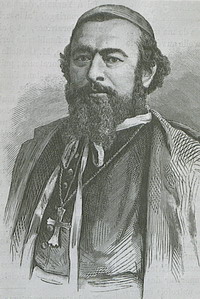
Bishop Adrien-Hippolyte Languillat, S.J. (1808-1878), vicar apostolic of Southeastern Chi-Li and Kiangnan.
Since 1901 annals have been published; in 1897-98, the director, Stanislas Chevalier, surveyed the Upper Yang-tze from I-ch’ang to P’ing-shan-hien and published a fine folio atlas of the great river, consisting of sixty-four sheets (1899). Under the direction of Pierre Heude (b. at Fougères, Brittany, 25 June, 1836; d. at Zi-ka-wei, 3 Jan., 1902) a museum of natural history was started, in connection with which were issued “Mémoires concernant l’historie naturelle de l’empirechinois” which are of great interest. Mention should also be made of the valuable series of monographs (twenty-five up to 1908) printed under the general heading “Variétés sinologiques”; in this work Henri Havret took the leading part after 1892. These monographs treat of various provinces, of examinations, of the Great Canal, of landed property, of the Jews, etc. It may be added that Fathers Couvreur, Debesse, and Petillion published good guides or dictionaries of the Chinese language, and Angelo Zottoli compiled the “Cursus Litterature sinicæ”. The Jesuits of this mission belong to the province of France. Since 1903, a quarterly under the title “Relations du Chine” has been issued at the head-quarters in Paris.
In 1856 part of the Chi-li province was also entrusted to the care of the Jesuits, and Adrien Languillat (b. 28 Sept., 1808; d. at Zi-ka-wei, 29 Nov., 1878) was consecrated 22 March, 1857, Bishop of Sergiopolis, and was the first Vicar Apostolic of South-Eastern Chi-li. This mission suffered greatly during the Boxer Rebellion. Some of its members have distinguished themselves by their publications, e.g., Séraphin Couvreur (b. 14 Jan., 1856), who compiled large dictionaries and made translations of the Chinese classics; Leo Wieger (b. 9 July, 1856), author of “Rudiments de la langue chinoise”. The Jesuits of this mission belong to the province of Champagne, the head-quarters being at Amiens. Since November, 1898, they have edited a periodical entitled “Chine, Ceylon, Madagascar”.
Dominicans
The first missionary to arrive in China in modern times was the Portuguese Dominican, Gaspar da Cruz (1555), whose successors were expelled by the mandarins, the latters’ fears having been aroused. Gaspar da Cruz wrote a book entitled “Tractado . . . da China” (1569). The Dominican mission was created in 1631 and 1633 in the Fu-kien province by Angelo Coqui and Thomas Serra. The well-known Dominican, Juan Bautista de Moralez (b. at Eeija, Spain, 1597; d. in Fu-kien, 17 Sept., 1664), who took an energetic part in the question of the Rites, arrived in 1637. In 1747, the Dominican Bishop Sanz, of Maurocastrum, was martyred with Fathers Alcobar, Royo, Diaz, and Bishops Francisco Serrano. Francisco Varo (Wan Tai-kwo), who arrived in China in 1654, published the “Arte de la Lengua mandarina” (Canton. 1703), which was the basis of Fourmont’s “Grammatica Duplex”. Beginning in 1866, the Dominicans printed for many years at Manila “El Correo Sino-Annamita”, which embodied the letters from their missionaries in China, Formosa, and Tong-king. The Dominicans have but two vicariates in China: Fu-kien and Amoy (the latter embracing Formosa), the Philippine Islands being the centre of their activity.
Franciscans
In 1579, Pedro d’Alfaro, guardian of the province of St. Joseph, in the Philippine Islands, with Giovanni Battista of Pesaro, Sebastian de Baera (or of St. Francis), and Augustin de Tordesillas, made a stay of seven months in China, but the first Franciscan with a special mission to China was Antonio de Santa Maria (Li, b. at Baltanas, Palencia, Spain; died at Canton, 13 May, 1669), who was sent to China in May, 1633, and took an active part in their discussion over the Rites. Among the most remarkable of these friars should be mentioned Basilio Brollo, better known as Baile de Glenmona (Ye T’sung-hien, b. at Gemona, Italy, 25 March, 1648; d. in the Shen-si province, 13 August, 1703), who went to China in 1860, became Vicar Apostolic of Shen-si in 1700; compiler of the Chinese-Latin dictionary “Han-se-tze-yi”, copied by De Guignes in his great work published in Paris in 1813, by order of Napoleon I. Also Carlo Orazio Castorano (eighteenth century), author of many works. Most of the Franciscans of China are Italian, though Eastern Shan-tung was made a separate vicariate Apostolic in 1894, for French Friars Minor.
Augustinians
In 1577, two Spanish Augustinians, Pedro Martin de Herrada and Geronimo Marin, came to Fu-kien, where they remained but four months and sixteen days. The first general work on China was written by the Augustinian Juan Gonzales de Mendoïa (Rome, 1585) and translated into most languages. It was not until 1680 that Alvaro de Benevente arrived in China; he was consecrated titular Bishop of Ascalon and placed at the head of the newly created vicariate of Kiang-si (1699) with his residence at Kan-chou. He died suddenly at Macao in 1705 and was not replaced, the Vicar Apostolic of Fu-kien taking charge also of Kiang-si and Che-kiang. The Augustinians had been absent from China for some time, when, it 1879, they sent from Manila Elias Suarez and Agustæn Villanueva to take charge of part of Hu-nan which on 19 Sept. was erected into a vicariate under Saturin de la Torre.
Société des Missions Estrangères
The creation in 1622 of the Sacra Congregatio de Propagandâ Fide made it possible to centralize the work of missions in order that their wants might be studied and their field of action broadened. No apostle was more eager than Alexandre de Rhodes, S.J. (b. at Avignon, 15 March, 1591; d. at Ispahan, 5 Nov., 1660) in appealing to Rome to make known the want of priests for numerous missions. He had thoroughly studied the question and travelled extensively in China, Cochin-China, Tong-king, and Persia. Pope Innocent X wished to consecrate Père de Rhodes bishop, but through modesty the missionary declined this honor. His reward was to consist in the success of the cause he so warmly advocated. On 7 August, 1651, Propaganda begged the pope to appoint a patriarch, two or three archbishops, and twelve bishops to the various churches of Eastern Asia. By a brief of 17 August, 1658, Alexander VII nominated Franïois Pallu, Canon of St. Martin of Tours, and titular Bishop of Heliopolis, and Pierre de la Motte Lambert, titular Bishop of Berytus, to take charge of the missions in China and the neighboring countries, with the power of choosing a third vicar Apostolic. Their choice fell on Cotolendi, vicar of Sainte-Madeleine at Aix-en-Provence. The vicars Apostolic asked Propaganda for authority to found a seminary for the conversion of infidels and the training of missionaries. Jean Duval, in religion Dom Bernard of St. Theresa, a Barefooted Carmelite, vicar Apostolic of Persia and titular Bishop of Babylon, donated a suitable site in Paris (16 March, 1663) and the directors took possession, 27 Oct, 1664. This was the beginning of the Société des Missions Estrangères. The first superiors were Vincent de Meurs of Tréguier (1664-68) and Michel Gazil of Tours (1668-70). The first directors were Michel Gazil (d. 14 Jan., 1697), and Armand Poitevin (d. 1682). Pierre de la Motte Lambert and Jacques de Bourges were the first missionaries who left Paris. The first departure from the Paris seminary took place 8 Nov., 1665. The missionaries embarked at La Rochelle, 14 March, 1666.
The Missions Estrangères had priests at Nan-king (Cotolendi died on the journey; Laneau, who resided at Siam); in the province of Fu-kien (Pallu, 1679-84; Charles Maigrot, 1697-1707); in the province of Sze-ch’wan (Artsu de Lyonne, 1697-1713); in the province of Yun-nan (Philibert le Blanc, 16697; Enjobert de Martillat, 1727-52). Notwithstanding the hostility of Portugal, the Missions Estrangères continued to flourish, and to-day they are spread over a great portion of the Chinese Empire, besides having missions in Japan, Tong-king, Chocin-China, Cambodia, Siam, Malacca, Burma, and India. There is a procurator at Hong-Kong and one at Shang-hai, and a sanatorium (Béthanie) at Hong-Kong. In the island of Hong-Kong, the society conducts a printing office at Pakfulum, called “Imprimerie de Nazareth”, where books are issued no only in French and Latin, but also in Chinese, Annamite, Japanese, Korean, Cambodian, Bahnar, Malay, and Tibetan. The priests of the Missions Estrangères have made a special study of languages and have published the following dictionaries: Pigneaux and Taberd, “Dict. Anamito-latinum” (Serampore, 1833); Taberd, “Dict. Latino-Anamiticum” (Serampore, 1838); “Vocabulaire Cochinchinois” (1838); Theurel, “Dict. Anamitico-Latinum” (Ninh-phu, 1877); Ravier, “Dict Latino-Anamiticum” (Ninh-phu, 1880); Pallegoix, “Dict. Linguae Thai” (Paris, 1854); “Dict. coréen-franïais” (Yokohama, 1880); “Dict. chinois-franïais (dialect of western China, Hong-Kong, 1893); Dourisboure, “Dict. Bahnar-franïais” (Hong-Kong, 1889); Desgodins, “Dict. thibétain-latin-franccais” (Hong-Kong, 1899).
Lazarists (Cong. Missionis)
The first Lazarists were sent to China by Propaganda; Luigi Antonio Appiani (Pie), Johann Mullener (Mo) in 1699, T. Pedrini (Te) in 1710. Appiani (b. at Dogliani, 22 March, 1663; d. 29 Aug., 1732), was vice-visitor in China, Mullener (b. at Bremen, 4 Oct. 1673; d. 17 Dec. 1742), titular Bishop of Myriopolis, was the second vicar Apostolic of Sze-ch’wan. Pedrini (born at Fermo, Italy; d. at Peking, 10 Dec., 1746) took a very active part in the discussion over the Rites. However it was not until they replaced the Jesuits at Peking, that the Lazarists got a firm footing in China. When the Society of Jesus was suppressed by Clement XIV, the offer of the succession was declined by the Missions Estrangères of Paris, and was finally accepted, though not without reluctance, by the Lazarists, and confirmed by a Roman decree of 7 Dec., 1783, approved of by Louis XVI of France at Versailles, 25 Jan., 1784. The superior general, Antoine Jacquier, chose for the new missions Nicolas-Joseph Raux (b. at Ohain, Hainault, 14 April, 1754; d. 16 Nov. 1801); Jean-Joseph Ghislain (b. at Salles, Diocese of Cambrai, 5 May, 1751; d. 12 August, 1812), and Brother Charles Portis. They arrived at Canton, 29 August, 1784. Peking, however, had to be abandoned during the greater part of the nineteenth century, and was finally recovered after the war of 1860, by Bishop Joseph-Martial Moulay (b. at Figeac, 2 Aug., 1807; d. 4 Dec., 1868), Vicar Apostolic of Northern Chi-li. Monsignor Alphonse-Pierre Favier, a Lazarist, titular bishop of Pentacomia (b. 22 Sept., 1837), Vicar Apostolic of Peking during the Boxer rebellion, was one of the successors of Bishop Mouly. Among the remarkable Lazarists of China, mention may be made of Joachim-Affonso Gonïalves (b. in Portugal, 23 March, 1781; d. 3 Oct., 1844), a great sinologist, author of “Arte China”, and several grammars and dictionaries, and the celebrated naturalist Armand David, (b. at Espalette, 7 Sept., 1826, d. at Paris, 10 Nov., 1900). The well-known traveller in Tibet, Evariste-Régis Hue (b. at Caylus, 1 June, 1813; d. March 1860) was also a Lazarist. In the vicariates administered by the Lazarists are a number of Sisters of St. Vincent de Paul, who are devoted nurses in the hospitals. The Lazarists also have charge of the Work of the Holy Childhood, for the redemption of forsaken native children, with headquarters at T’ing-hi (Chusan Island). The Lazarists have a procurator at Shanghai. Since 1832 they have published the “Annales de la Congrégation de la Mission”. The head-quarters of the mission at at Paris.
The Belgian Congregation of the Immaculate Heart of Mary (Imm. Cord. B. M. V. de Scheutveld)
This congregation was established at Brussels by a retired military chaplain, Théophile Verbist (b. at Antwerp, 1823; d. in Mongolia, 24 Feb., 1868). His first companion was Van Segvelt, and he was soon joined by Franïois Vranckx and Verlinden, and later by Jacques Bax and Ferdinand Hamer, who were afterwards vicars Apostolic. The Belgian missions extended over Mongolia, Kan-su, and Central Asia. In February, 1889, this congregation established the periodical “Missions en Chine et au Congo”, published at Brussels in both French and Flemish. The head-quarters of the missions are at Scheutveld near Brussels.
Foreign Missions of Milan (Sem. Mediol. Miss. Ext.)
A new seminary was established at Milan, 31 July, 1850, by Monsignor A. Ramazzotti, later Bishop of Pavia, and Patriarch of Venice, with the help of Fathers Reina, Mazzucconi, Salerio, Ripamonti, and Guiseppe Marinoni (b. at Milan, 11 Oct, 1810; d. 27 Jan., 1891). The last named was the real founder of the order and its first director. The head-quarters are at Milan.
Priests of Steyl

Photo of Saint Fr. Arnold Janssen, S.V.D. and founder of Society of the Divine Word. He was canonized on October 5, 2003.
(Sem. Steylen. pro Miss. Ext. Soc. Verbi Divini) This congregation was founded in 1875 by Arnold Janssen, a priest of the Diocese of Münster (Westphalia), chaplain of the Ursaline Sisters at Kempen (Rhenish Prussia), and editor of the “Kliner Herz Jesu Bote”, at Steyl (Holland), near Tegelen and Venloo. The new German congregation obtained from the Franciscans the concession of part of Shan-tung of which Johann Baptist Anzer was appointed pro-vicar, 2 Jan., 1882, and vicar Apostolic, 22 Dec. 1885. When Bishop Anzer of Telepta died (24 Nov., 1903), he was replaced by Bishop Henninghaus. This mission is under German protectorate, with head-quarters at Steyl.
The Seminary of Sts. Peter and Paul (Sem. SS. Apost. Petri et Pauli de Urbe)
Founded at Rome by Pius IX in 1874, has a small mission in Southern Shen-si.
PROTECTORATE
The partition of the newly-found lands by the Holy See, at the end of the fifteenth century, assigned Asia to Portugal, which had the control of missionaries in China, by a Bull of Nicholas V (8 Jan., 1454). The first blow struck at this protectorate was the creation of the Sacra Congregatio de Propagandâ Fide by Gregory XV, 22 June, 1622, and the appointment of two French vicars Apostolic in 1658. The next was the sending of five Jesuits to China in 1685, by Louis XIV, who pledged himself to protect his subjects. The rivalry of Portugal and France in this mission field was no slight factor in the failure of the special missions of Cardinal de Tournon. Lazarists took the place of Jesuits at Peking with the agreement of France. When the Portuguese bishop, Gaetao Pires, died at Peking, 2 Nov. 1838, his country did not name a successor and his place was taken by the French Lazarists and their bishop, Mouly. The French ambassador, Th. Lagrené, signed a treaty at Whampoa, 24 Oct., 1844, in which it is stipulated (art. XXIII) that the French shall have the right to establish churches, hospitals, schools, and cemeteries.
Again in Art. XIII of the French Treaty of T’ien-tsin. it was stipulated that protection should be granted to missionaries travelling with regular passports in the interior of China, and that all edicts against the Christian religion should be abrogated. By art. VI of the French Peking Convention of 1860, it was agreed that all the buildings confiscated by the Chinese should be restored to the Christians through the French Legation at Peking. Four churches of the capital, or their sites, were then surrendered to the French Ambassador, Baron Gros, who issued passports to twenty-eight missionaries of various congregations and nationalities. Portugal did not protest or interfere, leaving France undisturbed in the exercise of her protectorate over all the missions in China.
On 20 February, 1865, M. Berthemy, the French Minister at Peking, had a correspondence with the Tsung-il Yamen, with regard to the purchase of lands and houses by French missionaries. The question was definitely settled by M. Gérard, 14 April, 1895, and the agreement is known as the “Berthemy Convention”. In 1885 an attempt was made to send a papal nuncio or legate to Peking, but when France observed that it would interfere with her protectorate, Rome did not insist. In 1890-91, after lengthy negotiations with the Holy See and the German Bishop Anzer of Shan-tung, the German Government succeeded in having German missions placed under its protectorate. Of course France could not object to the protection given by a sovereign to his own subjects. Arrangements have also been made with Italy for the protection of Italian subjects, but the matter is not so simple in this case on account of the relations between the Italian Government and the Holy See. These claims have no practical effect on the protectorate of France, which, with the Mission Etrangères of Paris, the Lazarists, and the French Jesuits, has the lion’s share in this immense field of evangelization.
Nève, Etablissment et destruction de la première chrétiénte en Chine (Louvain, 1864); Dabry de Theirsant, Le catholicisme en Chine au VIIIe siècle (Paris, 1877); D’Ollone, La Chine novatrice et guerrière (Paris, 1906), iii, 112-14, vi, 132-53; Rohrbacher, Hist univ. de l’église cath. (Paris, 1857), X, 179-84, XI, 61-73; Parker, The Earliest Christianity in China in Dublin Rev. (1904), 380-404; Idem, China and Religion (London, 1905), vi, 120-83, ix, 178-208; Henrion, Hist. générale des missions cath. depuis le XIIIe siècle jusqu’ê nos jours (Paris, 1847); Yule, The Book of Marco Polo, the Venetian, concerning the Kingdoms and Marvels of the East (London, 1875); Cordier, Les voyages en Asie au XIVe siècle du B. Frère Odoric du Pordenone (Paris, 1891); Huc, Le christianisme en Chine, en Tartarie et au Tibet (Paris, 1857-58), tr. Hazlitt (London, 1857, New York, 1887); Marshall, Christian Missions, Their Agents, Methods and Results (London, 1862); Cordier, Relations de la Chine avec les puissances étrangères (Paris, 1901); Parker, The Preaching of the Gospel in China, in China Rev. (1889), Vol. XVIII, 152-77; Fink; The Sicawei Observatory in East of Asia Magazine (1902), I, 350-77; Kannengeisner, Missions cath. (Paris, 1900); Edkins, Religion in China (London, 1905), xvi, 166-77; Roy, Hist. abrégée des missions cath. depuis le XVe siècle jusqu’ê nos jours (Tours, 1855); Piolet, Les missions cath. franïaises (Paris, 1904), III; Louvet, Les missions cath. au XIXe siècle (Lille, Paris, 1895), xii, 215-34; Victor Bernardin de Rouen, Hist, univ. des missions franciscaines (Paris, 1898), II, III; Launay, Hist. de la Société des Missions-Etrangères (Paris, 1896); Launay, La mission du Koang-si (Paris, 1903); Raynaud, Another China (Dublin, 1897); Leroy, En Chine, au Tché-li S.E. (Lille, 1900); Palâtre, La missions du Kiang-nan: son hist. et ses oeuvres (Paris, 1900); Casartelli, Catholic Missions, (London, 1891); Fauvell, Nos missionaires, patriotes et savantes (Paris, 1900); Michie, Political Obstacles to Missionary Success in China (Hong-Kong, 1901).
cfr. HENRI CORDIER (Catholic Encyclopedia)
